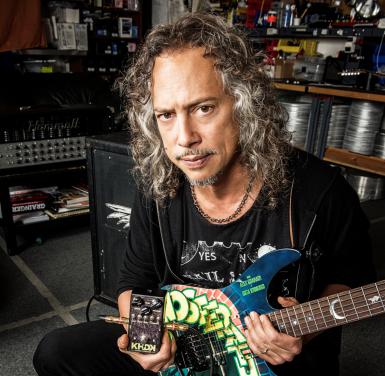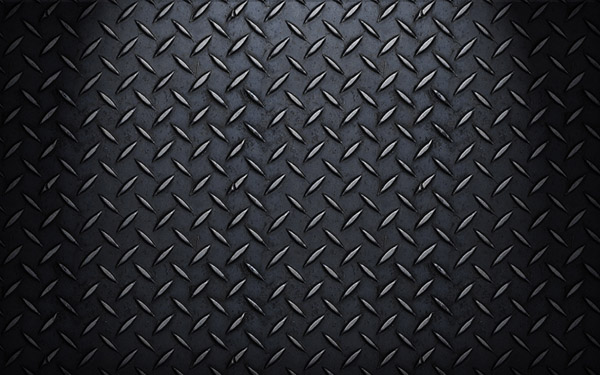Kirk Hammett Confirms Metallica Are Recording New Songs, Expresses Desire to Create Horror Film
As Metallica continue to work on the follow-up to 2008’s Death Magnetic, guitarist Kirk Hammett has been keeping busy with his numerous other interests. In addition to his well-received Fear FestEvil horror festival and KVH toy company, he’s also part of KHDK Electronics, who are releasing the new Ghoul Screamer pedal. I had the chance to chat with Hammett about all of those subjects and more, including his goal of making his own horror movie.
Chad Bowar: We’re just a few days away from Halloween, which I’m guessing is probably the biggest holiday of the year in the Hammett household.
Kirk Hammett: Oh yes. In fact, my kids are having a Halloween party tonight, because they want to be able to hang out with their friends in costume rather than be too busy going house to house hitting people up for candy.
In other words, they wanted an opportunity to dress up, and so they said, “Hey, Dad, can we have a Halloween party and invite all our friends in costumes?” My wife and I are like, “Yeah, absolutely. Do whatever you want,” because really, it’s Halloween around here pretty much three hundred and sixty-five days a year.
Tell me how you decided to get into the guitar pedal business when you formed KHDK Electronics with Dave Karon a few years ago.
I’ve known Dave for a while, him and I worked together when he was at Randall, and we really hit it off well. He was someone that had a lot of great ideas, and had a good instinct for the music industry. One day we were sitting around. I was lamenting the fact that he wasn’t working at Randall anymore, and he said, “That doesn’t mean we can’t still work together.
Let’s just form a pedal company.”
I looked at him and I said, “Yes, let’s.” That’s basically how it came about, but as you go deeper into it, basically what we’re trying to do is, we’re trying to come up with pedals that are new and different and unique, that have not been seen before.
Our first pedal which is totally over the top, was a distortion pedal, based on a pedal that I bought somewhere in France fifteen years ago, an obscure pedal that I’ve never seen ever since.
It was falling apart, and I said, “Dave, you have to remake this pedal and let’s improve on it.” He took it apart, took it to his engineer. We reverse engineered it, and added some things to it and made it more sturdy and more durable and better sounding. That was our first pedal, distortion pedal.
So I said to him, “You know, I love my Tube Screamer, I’ve recorded with it over all these years. I take it on tour, but sometimes I just sit there and I stare at it, and I think, “It’s not enough.” It would be great if I could get more out of this little box that only has three little knobs. It’s an amazing sound that it generates. It’s a standard for guitar players who want to get a warm tube-type of tone, but I’m not getting enough out of it, and so I said to Dave, “Dave, let’s make a Tube Screamer on steroids.”
A few months later the Ghoul Screamer shows up, the prototype, and we go through and make a few changes, and then come up with another prototype, and that’s pretty much what you guys see now, is what the Ghoul Screamer is. For me, it’s great because I finally have something that I’ve been needing for a long time, even though I had to go out and build it myself with the help of Dave and his crew.
I’m really, really proud of the fact that I built it for myself knowing that once other musicians see it, they’re going to go, “Oh yeah! I need this, too!” And realizing that how useful and how functional this pedal can be, and how much of an improvement this pedal can be over its predecessor, which to me is one of the greatest pedals in the world.
Do you have any plans of branching out into other types of gear, or are you going to stick with the pedals?
We’re going to stick with the pedals. We’re not going to get into rack mounted gear. We’re not going to just all the sudden decide to start building amps or something. What’s really an incentive to us is being able to build just pedals, and pedals that are small enough to put on your pedal board, just for maximum results, and that hadn’t been possible until ten, fifteen years ago. The technology, and circuits, and transistors, and software enabling bigger things to be built smaller.
Now that the technology is out there we have a couple ideas for pedals that are to me, are just totally needed, totally mind blowing, and totally inspiring, and I would love to tell you about them, but I’m too paranoid that someone’s going to beat us to the punch, you know?
With the success of the first two, is there going to be another Fear FestEvil next spring?
We’re trying to figure that out, but we actually have a lot planned in the KVH world. All I have to say is keep posted. We’re just brainstorming ideas for the new year. It’s something that I get just so much fun out of. Yeah, it’s great. As a horror guy, and also as a metal guy, I just love meeting other people who are into the same stuff. Those are my people. Those are the people that I’m reaching out to.
Your book Too Much Horror Business came out a few years ago. What are some of the big or notable pieces that you’ve added to your collection since that book came out?
I got this amazing piece. It’s called the Nebularium. It’s a round, I would say maybe two feet by three feet, circle made by Bausch and Lomb in 1931. It’s a round mirror, and if you watch the first three Frankenstein movies, it’s in the lab, and it’s part of the lab scenes. I managed to find it and I was able to pick it up. It’s in, not only the first three Frankensteinmovies, but it’s also in Mask of Fu Manchu, it’s in Abbott and Costello Meet Frankenstein. It’s in Young Frankenstein and The Man With Two Brains. It’s in all these movies.
It’s great, and I managed to pick that up. It’s something that I’m really, really, psyched to add to the collection, because over the years I’ve been piecemealing pieces of lab equipment that are in those first three Frankenstein movies. It still exists. It’s all spread out between all these different collectors, and over the years I’ve been slowly acquiring pieces in the hopes of getting enough pieces to actually recreate part of the lab scene.
That’s one of my longer term goals, and whether or not I’m successful at it or not remains to be seen. That’s one of the coolest pieces I’ve gotten. I’ve gotten a few movie posters that I intend on putting in the second book. What I want to do is keep that exclusively for my second book.
You mentioned earlier about how heavy metal and horror go together. There have been quite a few movies that have tried to combine the two to various levels of success. Are there any heavy metal horror movies that are your favorites?
Trick or Treat is the one that always comes up, and why is that? My favorite horror movie that has music in it is Phantom of the Paradise. I don’t know if that even registers with what you’re asking me, but I love that movie, and I love the phantom’s mask. This motorcycle helmet-type mask is so super cool. A lot of the horror metal movies that have come out, I think are pretty decent, but none of them has been very serious.
I’d like to maybe be the first one to make one more serious, and would be a little bit more believable. That’s a weird word to use when you’re talking about horror movies and heavy metal. I would make something a little bit more serious.
So maybe the next career path is branching out into making horror movies?
I definitely want to make a horror movie. I just have to find someone to pay for it. I have learned through making Some Kind of Monster and Through the Never with Metallica that movies are expensive. I think the most expensive thing you can ever get into is making movies, and that’s why a lot of times people find other people to pay for their movies, because it’s f–king expensive.
I’d love to make a movie if someone else paid for it. I don’t want to have to finance another movie again. We’ve already financed two. I didn’t know the ins and outs of that, the ups and downs, the pros and cons. I would go more the Hollywood route, which is find an investor to invest in the movie and pay for it. Besides, the type of movie I want to make would probably be a period piece, and then probably be upwards of twenty to twenty-five million dollars, and that’s a figure that is for the experts, for the big boys.
Metallica are at the point in your career where you don’t have to record new albums. You’re able to do it when you want and how you want. As an artist, is that freeing?
Absolutely. One always wants to work at the pace that they’re most comfortable at. It’s been about, what, seven or eight years since our last album? It doesn’t feel like that to me, but I know it is. Our first three albums came out our first three years, and for some reason that boggles my mind nowadays. Back then, it was just what everyone did. New year, new album and tour.
Even a generation before that it was every six months a new album and tour. So, having said all that, taking seven or eight years between albums is a lot of time, but we’ve filled it up with other things, like making a movie, making an album with Lou Reed, going on tour pretty regularly.
Let me just say that I’m grateful that we’re at a point where we can put out an album at our own pace, because there’s just so much other stuff that takes up Metallica time that’s maybe not as equally as important, but just as relevant.
So, the answer to your question is yeah, it’s great being able to work at your own pace, and still be able to be a father and be a husband, and everything else that comes in the wake of that. We have songs, and we are recording them, so that’s a good sign.
The No Life ‘Til Leather reissue, cassette version came out on Record Store Day earlier this year, and they said there was going to be a CD version at some point. Do you know when?
I haven’t seen the timetable on that one, but I just love the fact that we released a cassette in 2015. How many people have done that?








